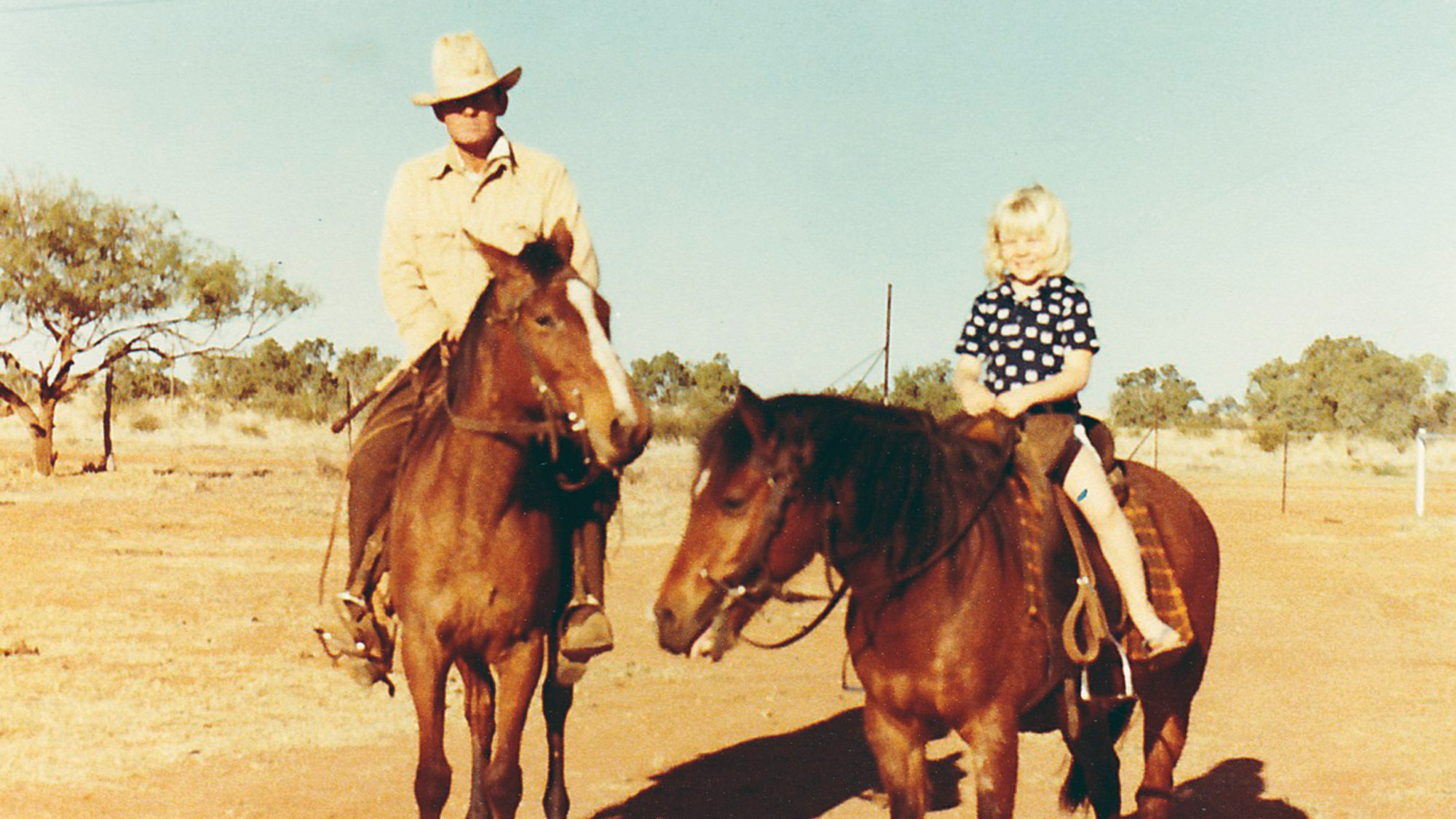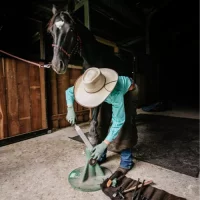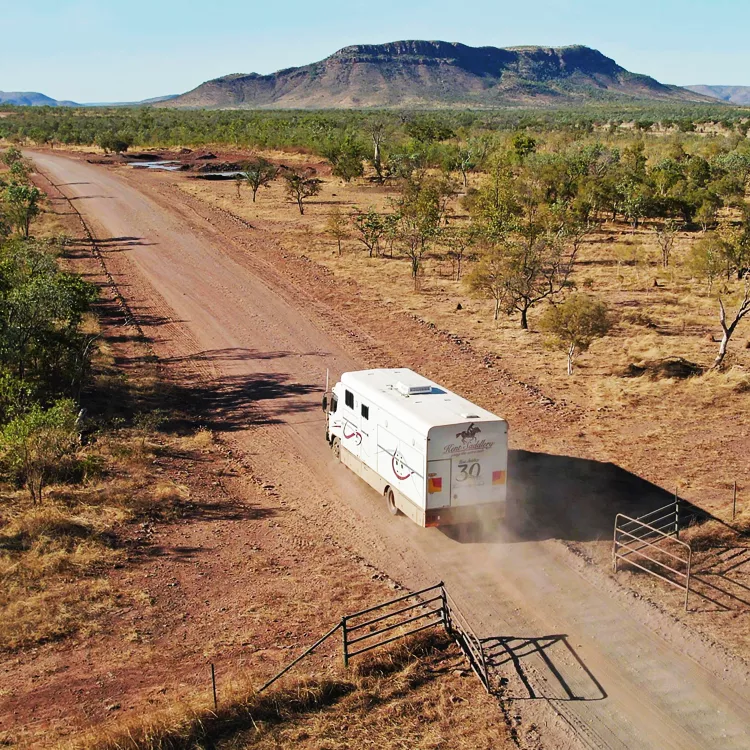Keith Chapman – Mt Isa, QLD

“I’ll do that!”
A little less than seventy years ago, a contract drover and musterer lifted his grandson on to the back of a horse and for Keith Chapman a lifetime of stock work had begun.
In the 1950’s, Dajarra, one hundred and fifty five kilometres south of Mt Isa, Qld, was the biggest trucking centre in the world. Young Keith, born in Mt Isa and raised in Dajarra, knew every drover arriving in the town. From where he lived, he could see the mobs come to the water trough and he remembers that “every weekend my father would take me out ’til we met a drover that he knew was reliable and he’d leave me there with him for the weekend and then come back Sunday night and pick me up. As far as you went out, the drovers were about eight miles apart; coming in along the stock route. I just loved doing that, you know”. He laughs quietly, the childhood memories prompting conversation. “My grandmother had the only shop in the Dajarra and the drovers would come to pick up supplies. There was one drover used to come from Western Australia … he’d bring one mob every year; it’d take him six months … then he’d turn his plant around and walk ‘em back, wait for the wet season to finish and start out with another mob.”
The Dajarra school at the time had an enrolment of about seventy; “All my education was in Dajarra” Keith volunteers, “which wasn’t very much. I always felt that the teacher was against me. My father was a builder … done a bit of everything, and I think he had a good education. He never ever said, but you know I often wonder if my father might have been disappointed in me?” When his own son Shaun was in high school Keith advised him “don’t start with that ‘want-to-punch-the-school-teacher’ … even though I wanted to!Take notice of your teachers, they’re there to help you”. Keith and his wife Nola are proud that Shaun now has his own welding business in Charters Towers and their daughter Kelli is a fly-in fly-out I.T. manager working in the mining industry.
Keith was fourteen when he left home and went to work at Ardmore Station. “Yeah, I took a piece of old railway tarp for a swag cover; scrubbed it up … no mattress. I was at Ardmore for seven years. Those days there were 42,000 sheep and 17,000 shorthorn cattle on Ardmore; we used to shear in January, right in the Wet season, then we’d go mustering cattle. I haven’t had anything to do with sheep since.”
Keith’s recollections of life on Ardmore are probably typical of the experiences of most cattle station workers of that era. Camping out all the time, open bronc branding, hobbling out, blocking up and tender mustering (on the boundaries of Barkly Downs, May Downs, Oban and Stanbroke Stations) were all commonplace and stockmanship skills were ‘taught’ to Keith “by a tough, good head stockman who used to give it to me. Sometimes I wanted to kill him but I wasn’t big enough!” Apart from horses, the main means of transport through and around sandy creeks was an old Ford truck and water was carted on an old Austin truck.
About this time, Keith became acutely aware of his lack of education. “I used to see blokes on outstations and all they were doin’ was riding around fences on horseback and I thought “That’s what I’ll be doin’ … I’ve gotta do something with my life”.
Keith vividly remembers going to the bank agency at the post office to draw out some money. “You know everyone knows the postmaster and the postmaster knows everyone and on the withdrawal slip you sign your name and I can still see that … I put the ’K’ there and started way over, just big letters and the postmaster looked at it and asked, “What’s that there?” and I said, “That’s a ‘K’”, and he said, “Oh … righto”. I thought; “a bloke sits down and tries to write his name … I was only one step away from the thumb print you know.”
It was a sobering revelation for Ardmore’s young headstockman and he enrolled in a Stotts correspondence course, completed Grade 11, and then embarked on an accountancy course. “I’d sit down late at night and do that.”
Two years of work in the mines followed. Then, single and with some money saved, for a time he followed the rodeos. At a Taroom rodeo he looked for a bit of work and found a bloke who wanted fellas who could throw and tie up a bull … part of a program on a place called ’Hornet Bank’, where the owner wanted to open up the country and round up the scrubbers. “I’ll give it a go”, Keith decided. “So I went with him. He had the worst horses you’ve ever seen … none of his own … people gave horses to him to work and get them into shape.”
Keith describes the job they had to do. “We’d go out for two or three days and you’d have a mob of ropes around your horse’s neck and more strapped around your waist. It was pretty thick brigalow and pine tree country, and that bloke, he’d been there before … he knew all that country and he’d say, We’ll run ‘em and we’ll throw and tie ‘em in that opening. “That opening” he’d be talking about was just a little space among the trees.”
“So, righto” Keith remembers. “When you struck the mob, whatever came out in front of you, it was yours, and if you threw one into the timber a little bit, that bloke, he’d go crook … he‘d be yelling, “I thought I said in the opening, not in there!!”
“There were four, five of us just circling around and those cattle had no education whatsoever. They’d come out of anywhere … all Herefords and big horns on them like THAT ya know. You’d jump off your horse and them big horns would come around at you.”
For two days we’d catch the bulls off horseback and tie them to a tree. On the third day we’d bring the coacher cattle back to pick up the bulls. There was one bloke there … never seen a bloke like him. He’d get in the lead of those coachers and he was able to ride to every one of the bulls we had tied up … I dunno what he had but he was pretty bloody good.
The worst part was that third day. We’d come along and let them off the tree, and they’re fresh. You’d get a bull down, let him go and you’ve got your horse standing close by over there, ready to mount … and the first thing the bull lines up is your horse. When the bull hit his feet you could feel your horse’s heart thumping against your leg ‘cos they knew what was on. You had to make your horse meet that bull head on.
Then we’d have to dehorn and knee string ‘em (cut a sinew in one leg) so they couldn’t canter. They could walk and trot ok, and later on that sinew healed and then they could canter. By that time they were quieter; they’d stay in the mob.” “That was a good experience”, Keith concludes.
When that work finished, he stayed on at Hornet Bank, working for the owner, who was eighty-two years of age. In 1968, 1969 Keith was there when the centenary of a massacre at the station took place. Details of this terrible event are recorded in a book “The Hornet Bank Massacre”.
By way of contrast, Keith recalls a couple of incidents at Hornet Bank … gentle, humorous memories of his former employer. “Yeah, well he used to drink a rum every night that ol’ fella and he’d come in after dinner , and there was only two of us there apart from a married fella down in a cottage, and a gardener. Every morning I used to run the horses in before breakfast and the other fella would milk the cows … and every night the ol’ fella he’d say “Roy, you milk the cows … Keith, you run the horses,” then he’d turn round and walk out, see?
One night he came in and he said, “Roy, you milk the horses … Keith, you run the cows!”. He never even corrected himself; he just kept going!”
Another time he sent for me and I went up to the house and he said, “That sink is blocked up there … do you think you could unblock that sink?” and I said, “Yeah, righto; so I went and found a shifting spanner and I put a bucket under the S bend, screwed the plug out and let the water out. It was a bit blocked up so I cleared it, put the plug back, turned the water on and it was running ok.
We were both standing there watching it and I said “It’s right now, it’s cleared”. He put a hand on my shoulder and said, “Keith its good to have someone around who’s mechanically minded”.
Numbers of stations in Qld’s central West and Gulf, namely Neumayer Valley, Chatsworth, Riversleigh and Armraynald became familiar country to Keith as he continued to work in that part of Queensland. He met his wife Nola while he was at Armraynald; at that time Nola’s parents were managers on Cowan Downs.
Keiths first job at Calton Hills, near Mt Isa followed a stint as a salesman, working for a company which supplied hard rock equipment to the mines. Keith describes selling the equipment as a job where he copped a lot of abuse from dissatisfied customers … “the customer is always right, is that right?”, he asks. Keith was at Calton Hills for five years the first time, after which he was unable to renew his contract. After a brief time at Riversleigh Station, he worked for McMillans for five years and was again offered the job at Calton Hills. 2013 marked seven years of managing at the station and although twelve months previously Keith felt like he didn’t want to give it away, he had reached a stage where he was pleased to be handing over the managers role to someone younger. “I’m slowing up” he conceded.
Quite a bit earlier in his outback career, Keith saw himself “as a bit of a pug … thought I could fight a bit … had tickets on myself.” So when a Union rep visited the stock camp insisting that workers sign up for a union ticket, Keith was ready to retaliate. Following a verbal slinging match, Keith challenged the rep, “a little you can flog me, I’ll buy your union ticket.” And he said “Right”, and we trotted out there and he flogged me alright. I was sitting on the ground and I’m saying, “I’m still not getting a ticket!” There’s a quiet chuckle. “I didn’t get that ticket but I got a good hiding!”
Maybe it’s significant that the rebellious submission of the determined young pug and the superior strength of the little nuggetty thick-set fella is replaced by the reasoned resignation of an older, wiser fighter who knows when its time to step out of the ring?
In the roles of head stockman, overseer and manager, Keith considers that his methods of teaching and training young workers are tough, yet fair. He’s let them know, “I’ll do a lot of yelling at you but you’ll learn from that. I’ll yell at you but I won’t call you names. I’ll tell you where you went wrong and I probably won’t pat you on the back when you do something good”. With a nod of his head Keith affirms it. “They come alright, them fellas.”
Reflecting on a long working life spent mainly in and around cattle stations, Keith expresses satisfaction and a tinge of regret about “the things you want to do and you say “I’ll do that,” but then you’re too old eh? I tell a lot of young people, “If you’re gonna do something in your life, do it, do it straight away … don’t think about it.” A lot of us have done that eh? Plan something and you never get around to doin’ it!”
Recently, Keith was talking about retirement plans with his wife, Nola. “You know what I want to do?” he said. “I want to buy a guitar and learn music on it.”
When Keith first worked in a stock camp he had a guitar and he’d “sit and fool around, and there were a couple of other fellas would play; they were pretty good at it and I’d learn a bit off them. Three or four of us’d be playing and one bloke’d be singing and uh, I ‘spose when I got a job as a headstockman, I stopped with the guitar.” He smiles, “I’ve got a bit of arthritis in my fingers, so I dunno how I’ll go … I just dunno”. As if considering more possibilities, Keith adds “I started writin’ a lot of stuff too. You know, stories about my life … my daughter Kelli, she got me onto that.”
“You’re too old eh? Do it, do it straight away … don’t think about it”. It’s such good advice and Keith Chapman will most likely get around to doing it. He’ll write songs that he will now have time to play and sing.
Image captions:
1) Keith with daughter Kelli, Newmayer Valley Station, Qld Gulf, 1974















